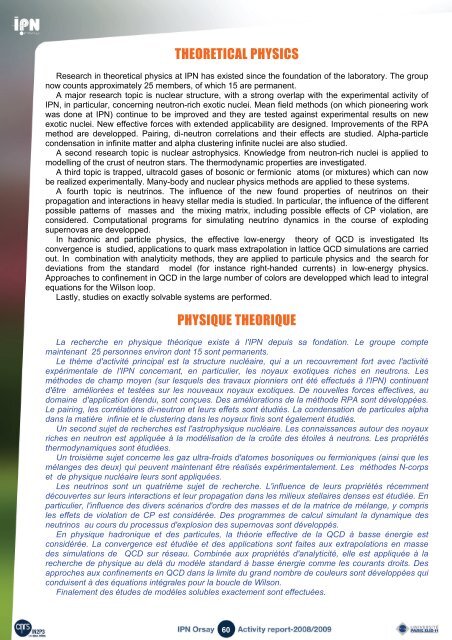exotic nuclei structure and reaction noyaux exotiques ... - IPN - IN2P3
exotic nuclei structure and reaction noyaux exotiques ... - IPN - IN2P3
exotic nuclei structure and reaction noyaux exotiques ... - IPN - IN2P3
You also want an ePaper? Increase the reach of your titles
YUMPU automatically turns print PDFs into web optimized ePapers that Google loves.
THEORETICAL PHYSICS<br />
Research in theoretical physics at <strong>IPN</strong> has existed since the foundation of the laboratory. The group<br />
now counts approximately 25 members, of which 15 are permanent.<br />
A major research topic is nuclear <strong>structure</strong>, with a strong overlap with the experimental activity of<br />
<strong>IPN</strong>, in particular, concerning neutron-rich <strong>exotic</strong> <strong>nuclei</strong>. Mean field methods (on which pioneering work<br />
was done at <strong>IPN</strong>) continue to be improved <strong>and</strong> they are tested against experimental results on new<br />
<strong>exotic</strong> <strong>nuclei</strong>. New effective forces with extended applicability are designed. Improvements of the RPA<br />
method are developped. Pairing, di-neutron correlations <strong>and</strong> their effects are studied. Alpha-particle<br />
condensation in infinite matter <strong>and</strong> alpha clustering infinite <strong>nuclei</strong> are also studied.<br />
A second research topic is nuclear astrophysics. Knowledge from neutron-rich <strong>nuclei</strong> is applied to<br />
modelling of the crust of neutron stars. The thermodynamic properties are investigated.<br />
A third topic is trapped, ultracold gases of bosonic or fermionic atoms (or mixtures) which can now<br />
be realized experimentally. Many-body <strong>and</strong> nuclear physics methods are applied to these systems.<br />
A fourth topic is neutrinos. The influence of the new found properties of neutrinos on their<br />
propagation <strong>and</strong> interactions in heavy stellar media is studied. In particular, the influence of the different<br />
possible patterns of masses <strong>and</strong> the mixing matrix, including possible effects of CP violation, are<br />
considered. Computational programs for simulating neutrino dynamics in the course of exploding<br />
supernovas are developped.<br />
In hadronic <strong>and</strong> particle physics, the effective low-energy theory of QCD is investigated Its<br />
convergence is studied, applications to quark mass extrapolation in lattice QCD simulations are carried<br />
out. In combination with analyticity methods, they are applied to particule physics <strong>and</strong> the search for<br />
deviations from the st<strong>and</strong>ard model (for instance right-h<strong>and</strong>ed currents) in low-energy physics.<br />
Approaches to confinement in QCD in the large number of colors are developped which lead to integral<br />
equations for the Wilson loop.<br />
Lastly, studies on exactly solvable systems are performed.<br />
PHYSIQUE THEORIQUE<br />
La recherche en physique théorique existe à l'<strong>IPN</strong> depuis sa fondation. Le groupe compte<br />
maintenant 25 personnes environ dont 15 sont permanents.<br />
Le thème d'activité principal est la <strong>structure</strong> nucléaire, qui a un recouvrement fort avec l'activité<br />
expérimentale de l'<strong>IPN</strong> concernant, en particulier, les <strong>noyaux</strong> <strong>exotiques</strong> riches en neutrons. Les<br />
méthodes de champ moyen (sur lesquels des travaux pionniers ont été effectués à l'<strong>IPN</strong>) continuent<br />
d'être améliorées et testées sur les nouveaux <strong>noyaux</strong> <strong>exotiques</strong>. De nouvelles forces effectives, au<br />
domaine d'application étendu, sont conçues. Des améliorations de la méthode RPA sont développées.<br />
Le pairing, les corrélations di-neutron et leurs effets sont étudiés. La condensation de particules alpha<br />
dans la matière infinie et le clustering dans les <strong>noyaux</strong> finis sont également étudiés.<br />
Un second sujet de recherches est l'astrophysique nucléaire. Les connaissances autour des <strong>noyaux</strong><br />
riches en neutron est appliquée à la modélisation de la croûte des étoiles à neutrons. Les propriétés<br />
thermodynamiques sont étudiées.<br />
Un troisième sujet concerne les gaz ultra-froids d'atomes bosoniques ou fermioniques (ainsi que les<br />
mélanges des deux) qui peuvent maintenant être réalisés expérimentalement. Les méthodes N-corps<br />
et de physique nucléaire leurs sont appliquées.<br />
Les neutrinos sont un quatrième sujet de recherche. L'influence de leurs propriétés récemment<br />
découvertes sur leurs interactions et leur propagation dans les milieux stellaires denses est étudiée. En<br />
particulier, l'influence des divers scénarios d'ordre des masses et de la matrice de mélange, y compris<br />
les effets de violation de CP est considérée. Des programmes de calcul simulant la dynamique des<br />
neutrinos au cours du processus d'explosion des supernovas sont développés.<br />
En physique hadronique et des particules, la théorie effective de la QCD à basse énergie est<br />
considérée. La convergence est étudiée et des applications sont faites aux extrapolations en masse<br />
des simulations de QCD sur réseau. Combinée aux propriétés d'analyticité, elle est appliquée à la<br />
recherche de physique au delà du modèle st<strong>and</strong>ard à basse énergie comme les courants droits. Des<br />
approches aux confinements en QCD dans la limite du gr<strong>and</strong> nombre de couleurs sont développées qui<br />
conduisent à des équations intégrales pour la boucle de Wilson.<br />
Finalement des études de modèles solubles exactement sont effectuées.<br />
60

















